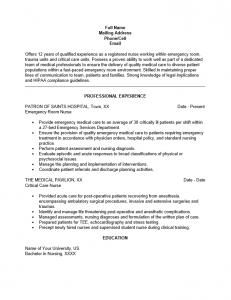Emergency Room Nurse Resume Template |
|
The Emergency Room Nurse Resume Template is a useful tool for any nurse who chooses to focus his or her career where emergency care is necessary (i.e. ambulances, emergency rooms, helicopters, sports arenas, urgent care centers, etc.). Emergency room nurses need the education and specialized training to deal with everything from the common cold to a gunshot wound. Therefore, it is imperative that a nurse be able to show on a written document, such as a resume, the level of skill and dedication he or she possesses.
When filling out this template, nurses should keep in mind that a hiring entity will absolutely need to make sure they are up to the task of providing emergency care under an immeasurable amount of stress. This means the resume must be straight and to the point. The entire resume should leave no question as to one’s credentials and ability to handle the position of an emergency room nurse. Thus, when taking the time out to fill this template out, make sure to use a succinct and professional language that concentrates more on technical jargon than empty buzzwords (though those can be useful if they are not abused). It is important to come across as highly intelligent, more than capable, and experienced with the conditions that will be prevalent when a patient faces a potentially life threatening medical event. While a template will take over any formatting issues, it is the content of a finely written resume that will ultimately gain someone an interview.
How to Write
Step 1. The first few lines are reserved for your full name and contact information.
Step 2. The introductory section should be composed of two or three sentences about your professional profile. The heading for this section may be left blank, the job title you are applying to or it may be titled “Profile”
Step 3. The next section, “Professional Experience,” is where you will list your employment history. This should be in chronological order. The basics stats such as name of employer, location, date range of employment, and the official job title should start each entry. This should be followed by a list of the duties performed there making specific mention of your proficiencies.
Step 4. The “Education” section is where a nurse’s academic credentials are placed. This should include your license information, where you went to school (including location), the type of degree you earned, and any certifications you have earned.
Step 5. It is usually a good idea to include a “Computer Skills” section where you list the software you know. Technical knowledge of software is always looked upon favorably.


